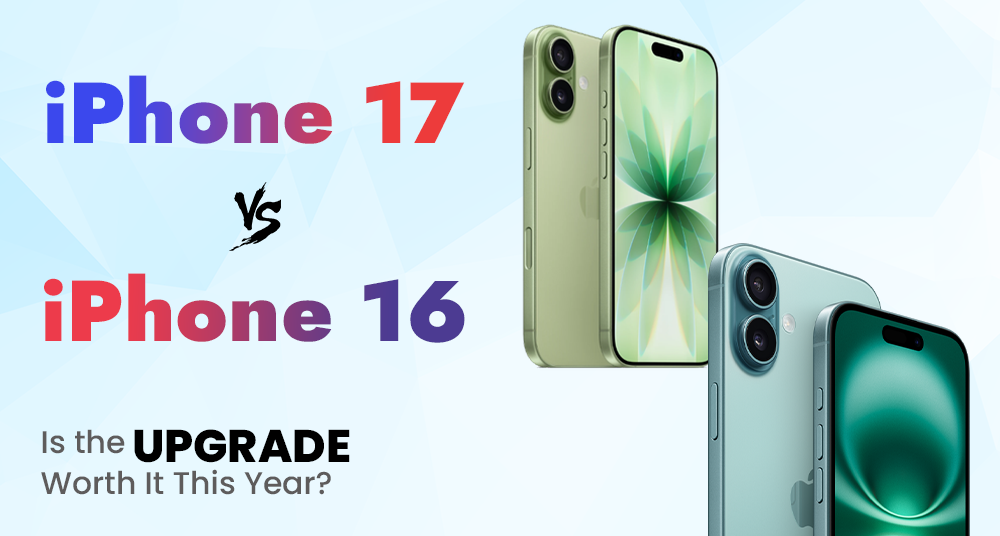Apple’s iPhone lineup has always set benchmarks for design, performance, and innovation, and the leap from iPhone 16 to iPhone 17 is no exception. While the iPhone 16 series already impressed users with advanced AI features, improved cameras, and better efficiency, the iPhone 17 takes things further with a refined design, enhanced display technology, stronger performance, and deeper integration of Apple Intelligence. Apple has also focused on battery life, sustainability, and user experience, making the new flagship both powerful and eco-conscious.
This comparison dives into everything that’s new in the iPhone 17 — from hardware upgrades and camera improvements to software enhancements and unique features — while also highlighting where it differs from the iPhone 16. If you’re wondering whether upgrading to the iPhone 17 is worth it, this detailed breakdown will help you make an informed decision.
Key Differences: iPhone 16 vs iPhone 17
| Feature Area | iPhone 16 (Base Models) | iPhone 17 (Expected / Confirmed) |
| Display / Screen | 6.1-inch Super Retina XDR OLED display. The base model has a 60Hz refresh rate. Peak outdoor brightness about 2,000 nits; typical brightness ~1,000. | Larger screen: ~6.3-inch. ProMotion support – i.e. up to 120Hz refresh rate for smoother animations & scrolling. Always-On display introduced in base model. Higher peak brightness outdoors (about 3,000 nits), improved anti-reflective coating. More scratch resistant front glass (Ceramic Shield 2) with ~3× better scratch resistance. |
| Chip / Performance | A18 chip, built on ~3 nm process. Good performance, efficiency. 8 GB RAM on base models; various storage tiers (128/256/512 GB) available. | Upgraded to A19 chip. More efficient, improved performance, better for future-proofing and “Apple Intelligence” features. New networking chip (called N1) included: Wi-Fi 7, newer Bluetooth version, etc. Possibly improved thermal management. |
| Camera System | Dual rear cameras: 48 MP main (Fusion) camera, 12 MP ultra-wide. Front camera ~12 MP. Some improvements in ultra-wide focusing etc. | Rear cameras upgraded: Both rear lenses are 48 MP in iPhone 17, including ultra-wide, with better zoom options (2× optical, etc). Front-facing camera improved: ~18 MP, new “Center Stage” style square sensor allowing portrait/landscape selfies without rotating the phone. Better low light performance, more features (HDR video, etc.). Also better image processing (new ISP), improved Neural Engine for AI/ML tasks. |
| Battery & Charging | Battery capacity ~3,561 mAh on iPhone 16 base, video playback time decent. Charging: wired, wireless (MagSafe etc), standards similar to previous years. | Slight bump in battery capacity for iPhone 17 (~3692 mAh for base model). Video playback and streaming times improved (estimates suggest ~30 hours video playback vs ~22 hours on iPhone 16). Faster charging: with a more powerful adapter (40W or greater) charging speeds improved. Wireless charging improvements; possible support for Qi2 / MagSafe improvements. |
| Design & Build | Aluminum frame, color-infused glass back, Ceramic Shield front. IP68 dust/water resistance. Sizes: base 6.1-inch; Plus model 6.7-inch. (Colors: multiple options. | Slightly larger screen size; improved scratch/corrosion resistance (new Ceramic Shield 2). New or refined anti-reflective coatings. Possible design tweaks: thinner bezels, perhaps slightly slimmer body, maybe new color options. Also physical buttons retained (Action Button / Camera Control etc.) |
| Other Features & Connectivity | Supports features like Dynamic Island, Face ID, IP68, MagSafe, Qi2 wireless charging, eSIM / SIM depending on region. USB-C port. WiFi/Bluetooth, GPS etc. | Enhanced connectivity: new networking chip (N1) with WiFi 7, Bluetooth improvements. Possibly better 5G modem efficiency. Better scratch resistance. Always-On display. Some UI tweaks, possibly improvements to Dynamic Island UI. |
What’s New That’s Worth Upgrading For
Whether upgrading makes sense depends largely on what you value. Here are the most meaningful improvements with iPhone 17, especially if you use your phone heavily, want better camera or display performance, or want more future-proof specs.
Smoother Display Experience
If you’re someone who scrolls a lot, plays fast paced games, watches video, or uses your phone in outdoor/bright sunlight, the jump from 60Hz to 120Hz + better outdoor brightness + improved reflectivity reduction will be very noticeable. The Always-On display also adds convenience.
Camera Improvements
The bigger jump in image quality comes from upgraded sensors (48MP ultra-wide, better front camera), better processing, more zoom flexibility. Selfies, video calls, and low-light photography will especially benefit.
Battery Life & Charging
Even a modest increase in battery capacity + better efficiency from the newer chip + improved charging speeds means less frequent charging and faster top-ups, which is helpful if you use your phone heavily or travel a lot.
Better Performance & Future-Proofing
The A19 chip, upgraded neural / ISP capabilities, and newer connectivity standards (WiFi 7 etc.) help make the iPhone 17 more ready for future software demands (AR/AI apps, etc.). If you plan to keep your phone for many years, these upgrades can matter.
Durability
More scratch-resistant glass, better coatings, potentially tougher build helps preserve appearance and usability over a longer time.
What Might Not Be Enough to Justify Upgrading (Unless You Care)
For some users, the gains may not be dramatic enough to upgrade, especially if you already have a recent iPhone or don’t use advanced features. Here are some of the areas where the iPhone 17 is less of a leap:
- If you’re already using an iPhone 16, you may not notice big changes for everyday tasks: texting, basic photography, web browsing, etc., will feel similar.
- For those who don’t care about high refresh rates, outdoor brightness, or camera tweaks, the base iPhone 16 might still serve well.
- Upgrading cost: new phones often come at higher prices; trading in or buying new means paying more, so you’ll want to ensure the incremental value is worth it to you.
- Accessory compatibility: cases, etc., might change slightly; some features (fast charging adapters, etc.) might need investment.
How Big Is the Upgrade (Real-World Perspective)
Here’s a realistic idea of what the user experience difference might be like:
| Use Case | With iPhone 16 | With iPhone 17 |
| Scrolling / UI smoothness | Standard, likely fine for many but some stutter in heavy animation or gaming. 60Hz limits fluidity. | Much smoother, especially in games, web/li feeds, UI transitions. 120Hz feels more modern and responsive. |
| Low light photography / selfies | Decent, but limited by sensor capabilities; front cam less sharp. | Clearer selfies, better low-light performance, more detail; more flexibility. |
| Outdoor visibility | Good, but may struggle under harsh sunlight / reflections. | Brighter display, better coatings, improved readability outdoors. |
| Battery under heavy use | Should manage a full day; under intensive tasks may need mid-day charging. | Improved battery life + more efficient chip + perhaps better power management features should extend usable time. |
| Longevity / software updates | Will still get updates for years; hardware is strong. | More future-proof, with newer chip + better hardware + new features likely to be supported longer. |
Cost & Value Consideration
- Price difference: iPhone 17 base models are priced higher than iPhone 16 when launched. The price premium should be justified by the upgraded features.
- Resale / trade-in: Newer model tends to retain value a bit longer. If you plan to resell in a couple of years, iPhone 17 might give slightly better return.
- Accessories and ecosystem: if you have high-quality accessories (fast charger, MagSafe charger, etc.), they might be usable; some improvements like fast wireless or WiFi 7 may require newer accessories.
- Opportunity cost: If you wait, there might be more improvements (Pro-level features, or waiting for a bigger drop in 17’s price).
| Model | Storage | Launch / Reference Price |
| iPhone 17 (base, standard) | 256 GB | ₹82,900 |
| iPhone 17 (512 GB) | 512 GB | ₹1,02,900 |
| iPhone 17 Pro / Pro Max / Air | various storages | Pro models go from ~₹1,34,900 upward; top-end Pro Max (2 TB) ~₹2,29,900 |
| iPhone 16 | 128 GB baseline (older stock) | ₹79,900 launch, but current discount/exchange offers bring it much lower; base/older variants have dropped below ~₹60,000 in many deals. |
Who should upgrade from iPhone 16 → iPhone 17?
Here are some decision prompts based on what kind of user you are:
- You should seriously consider upgrading if:
- Display quality, smoothness, and outdoor visibility are important to you.
- You take lots of photos / selfies, especially in low light.
- You use your phone heavily: streaming, gaming, travel — battery life improvements will matter.
- You want more future-proofing (for AI/ML features, better chips, newer connectivity).
- You dislike the limitations of 60Hz displays or struggle with visibility outdoors.
- You might wait (or skip) if:
- You’ve got a fairly recent iPhone (16 or 16 Pro) and are satisfied with performance and camera.
- You seldom use demanding features — mainly casual use like messaging, social, basic apps.
- The cost is a factor and the incremental upgrades (“nice to have”) aren’t compelling enough.
- You prefer waiting for price drops during sales or carrier deals.
Final Thoughts
The iPhone 17 offers some meaningful upgrades over the iPhone 16: smoother display, camera system enhancements, slightly better battery and charging, improved durability, and newer connectivity standards. For many users, especially those who use their phone heavily, take many photos or use it in bright lights outdoors, these improvements will feel worthwhile.
However, for users who primarily use phones for basic tasks, whose current device is still quite capable, or who are sensitive to cost, the iPhone 16 remains a strong phone — still modern, with many flagship-level features. The question isn’t just what’s new, but what you value, and whether the improvements align with your usage.
If you want, I can also put together a side-by-side spec sheet (India-pricing included) to help you decide more concretely. Do you want that?
FAQs
Is the iPhone 17 camera a huge leap over the 16?
For selfies and video yes — the front camera and Center Stage are noticeably better. For daylight rear photos the difference is more modest; improvements are more about processing and ultrawide upgrades.
Does iPhone 17 have USB-C like iPhone 16?
Yes — the switch to USB-C was introduced in iPhone 15/16 generations and continues.
How much better is battery life?
Lab tests show up to ~8–9 hours more for specific video playback/streaming tests vs. iPhone 16 — real-world gains depend on usage but are clearly improved.
Will the iPhone 16 still get software updates?
Yes — the iPhone 16 will continue to receive iOS updates for several years; Apple supports devices for a long time.
Is the iPhone 17 worth it for gamers?
Yes — A19 + ProMotion (base model) improves frame rates and responsiveness, so gamers get a better experience.
Should I wait for prices to drop?
If you don’t need the 17 immediately, waiting a few weeks/months after launch typically yields promos, carrier deals and better trade-in values for your old phone.
Related Blog: Top Shopping Apps for Festival Sale in India






What do you think?
It is nice to know your opinion. Leave a comment.